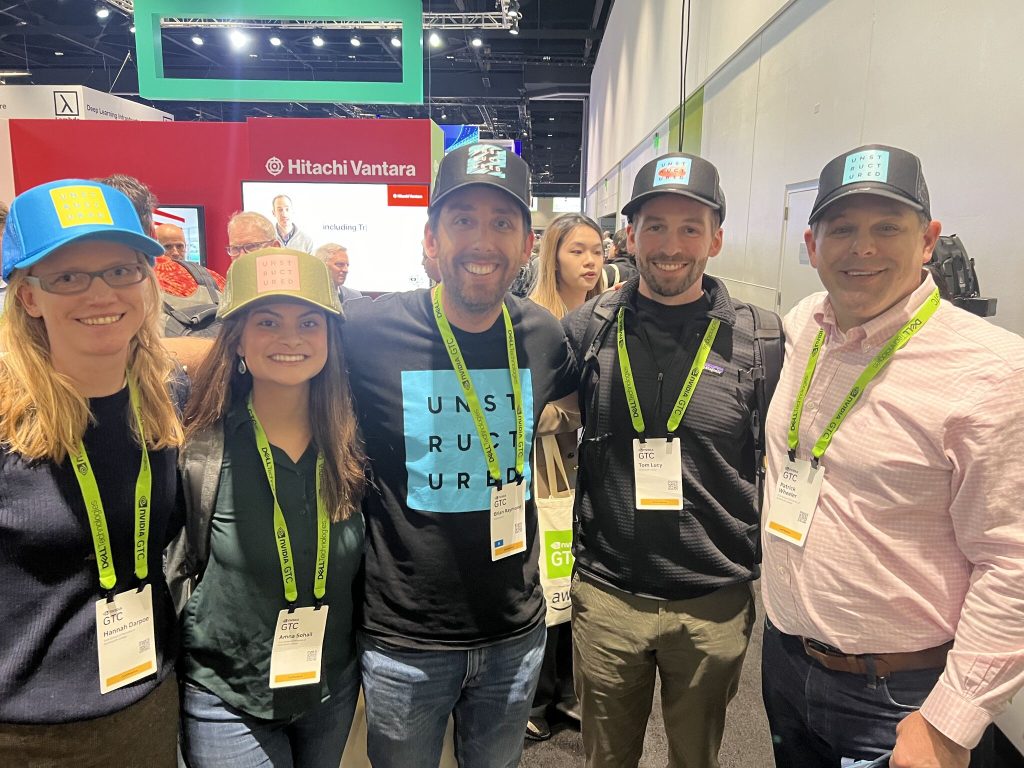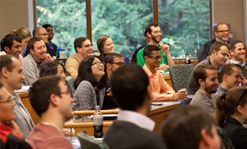Top Takeaways from NVIDIA 2024 GTC AI Conference
April 18th, 2024

Earlier in March, the Center for Digital Strategies Executive Director, Patrick Wheeler and three of our T’24 MBA Fellows, Amna Sohail, Tom Lucy, and Hannah Darpoe traveled to San Jose to attend NVIDIA’s GPU Technology Conference (GTC) in San Jose. It was an incredible opportunity to learn about the latest advancements in artificial intelligence (AI), data science, and accelerated computing within an environment of inspiring and cutting-edge developers, researchers, creators, IT decision makers, business leaders, and students.
While you can now checkout the GTC’s sessions on demand online, below are some of our top takeaways:
NVIDIA is nurturing a partnership ecosystem. Through symbiotic relationships with suppliers of advanced computing parts and buyers of compute resources, NVIDIA cements reliable supply chains and high demand for core products. This is particularly clear within the context of an ecosystem-wide focus on GenAI. At GTC, we saw the importance of partnerships on display during Jensen Huang’s keynote – in which he highlighted the products of many NVIDIA customers – and in the exhibit hall.
Omniverse is a major focus for NVIDIA and a path forward for the digitization of heavy industry. For years, the software industry has employed rapid prototyping to quickly iterate on designs and meet customer needs. Until recently, this has been much more difficult for makers of physical products, particularly within heavy industry. With omniverse and high-performance simulation tech enabled by NVIDIA’s GPUs, industrial firms can iterate product design through digital twins, leading to better products and promoting efficient use of scarce resources.
The marginal cost of producing text is now $0. The same will soon be said, if not already, for producing images and video. We heard this insight from the authors of “Attention Is All You Need,” the foundational paper for transformer neural network architecture, and they paired it with speculation that much of the world’s adjustment to this new reality is yet to come. As we saw with the internet’s power to bring the marginal cost of communication to $0, ways of living and working may dramatically change in unexpected ways.

The big opportunity with AI is not to replace people, but rather to find ways to augment their capabilities. For example, in the realm of marketing, AI has the opportunity to augment human creativity in areas ranging from ad generation to brand campaigns. In fact, Stephen Pretorius, CTO of WPP shared on the “AI and the Radical Transformation of Marketing” panel that “the (GenAI) prompt is the new art direction.”
Advancements in AI will power the future of areas such as life sciences and modern medicine. Companies such as NVIDIA are doubling down on these efforts through launching GenAI cloud service platforms such as BioNeMo. With BioNeMo, researchers can leverage pre-trained models and customize models with proprietary data to accelerate computer-aided drug discovery. Not only can AI help speed up the drug discovery process, but it has the potential to find uses for drug candidates that may have previously failed to produce results for the initial disease they were developed for.
There are two distinct ways that Generative AI can make enterprises more effective. The first is to increase the productivity of employees in the tasks they perform today. The second, and possibly more impactful way, is to eliminate certain steps employees or organizations are performing today. To achieve this transformation of business processes, organizations should reimagine what divisions will look like in 2-3 years, and the potential generative AI has in allowing these processes to operate in a different way.
Organizations must balance the needs for stability and reliability with the need to innovate. However, the nature of innovation is changing dramatically due to AI. For instance, software engineers will not need to rewrite all code; AI can handle that. With AI, the cost of prediction has gone down to $0 from “very expensive.” That means all problems can be reframed into prediction problems. The whole organization needs to mobilize to explore how AI can drive impact across the firm.
Companies should take seriously the challenge of building AI capabilities and applications in their enterprises. There seemed to be consensus that we need to pair centrally managed and built infrastructure and record systems with decentralized application development. This concept is not new in IT, but a year ago there wasn’t a roadmap or schema for doing this with AI. Today that exists, especially as companies move toward building enabling technologies for the edge of the enterprise to build more robust applications in their domains.

With AI, leaders do not want to make the same mistakes they made with social media. The acknowledgement that this is an important and exciting time was palpable, but so too was the desire to do this the right way and to build safeguards into the technology. While this sentiment is not enough to prevent bad outcomes, just the fact that leaders in the industry are talking about the risks gives us much more hope that AI’s problems are more likely to be addressed upfront, and not as an afterthought.
Another highlight of our experience was meeting with several Tuck alumni, including Brian Raymond T’17, founder and CEO of Unstructured.io, Maxwell Williams T’18, VP of AI Product Management at Wells Fargo, Kevin Collins T’99, Advisory Board Member at Serica, and Kakeru Tsubota T’23, Product Strategy and Operations Manager at ServiceNow.
Thank you to the Center for Digital Strategies for providing this opportunity and for enabling us to continue learning and growing in this rapidly evolving field of AI! We look forward to applying these learnings during our time at Tuck and beyond.







